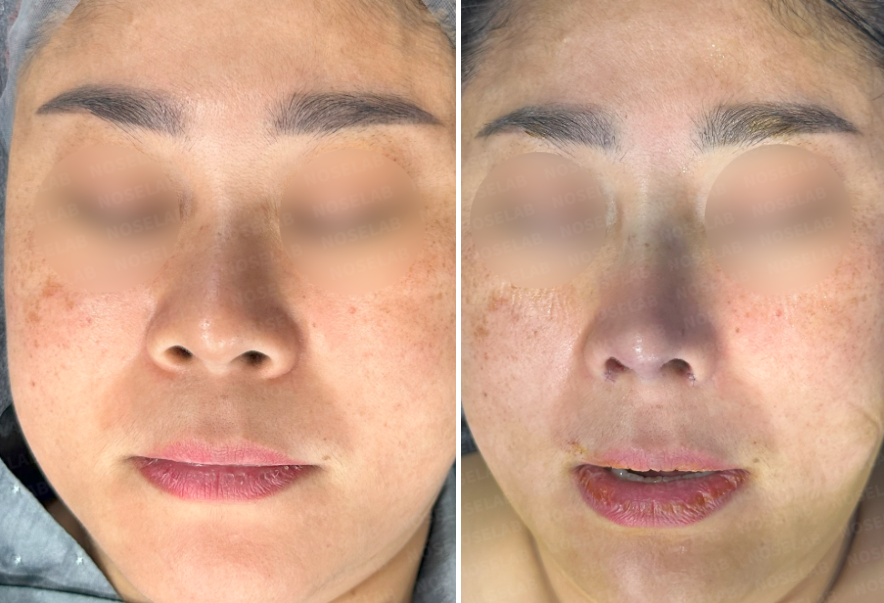Hello, this is Dr. Cha-Young Kang, Director of Nose Lab Clinic.
Today, I’d like to share the case of a patient who experienced nasal obstruction and diminished sense of smell, alongside aesthetic concerns about a short nose. This case demonstrates how a tailored rhinoplasty approach can achieve both functional and aesthetic outcomes.
1. Key Symptoms and Patient Goals

Design Consultation: Frontal View, Left Side View, and Oblique Side View Photos
Chronic nasal obstruction
Diminished sense of smell
Desire to lengthen a short nose
Excessive nostril show
Harmony with overall facial proportions
2. Preoperative Analysis

Design Consultation: Right Side View, Oblique Side View, and Nostril View Photos
a. Frontal View

Before (Left) / Immediately After (Right)
Excessive nostril exposure
Short and flat nose
Slight nasal deviation
b. Side View

Before (Left) / Immediately After (Right)
Low nasal bridge
Upturned nasal tip
Nose appears small relative to the face
c. Oblique View

Before (Left) / Immediately After (Right)
Pronounced mouth projection
Drooping nasal tip
d. Nostril View

Before (Left) / Immediately After (Right)
Asymmetrical nostrils
Left nostril larger and rounder
3. Surgical Plan and Medical Insights
Medical Observations
Deviated nasal septum (to the right)
Hypertrophic inferior turbinates indicating rhinitis
Likely nasal obstruction and impaired airflow affecting sense of smell
Surgical Steps
a. Functional Improvements
Septoplasty with rib cartilage graft: Corrected deviated septum.
Submucosal turbinate reduction using radiofrequency: Treated hypertrophic inferior turbinates to improve nasal airflow and alleviate rhinitis symptoms.
b. Structural Enhancements
Septal extension graft using rib cartilage: Lengthened the short nose.
Lateral osteotomy: Straightened deviated nasal bones.
Alar base reduction: Reduced the width of the nasal base to balance proportions.
Reinforced nasal tip support: Ensured long-term stability.
4. Postoperative Results
a. Functional Outcomes
Improved nasal airflow and space balance in both nasal passages.
Expected improvement in the sense of smell as airflow is directed toward the olfactory region.
Stable and balanced nasal structure.
b. Aesthetic Outcomes
Natural nose length, enhancing facial harmony.
Reduced nostril show with a refined nasal base.
Defined nasal tip with a proportional and feminine contour.
Adjusted nasolabial angle, reducing the appearance of a protruding mouth.

Immediately After Surgery: Frontal, Side, and Oblique Side View Photos

Immediately After Surgery: Nostril View Photos
5. Specialist Insights
The patient presented with dual concerns—functional impairment and aesthetic dissatisfaction. Addressing diminished olfactory function required prioritizing nasal airflow dynamics, ensuring that air reaches the olfactory epithelium effectively. By widening the nasal passages and optimizing structural alignment, we aimed for functional recovery.
Aesthetic goals were achieved through rib cartilage grafting, enabling a natural and proportional outcome without compromising nasal stability. This approach ensured both long-term durability and a feminine, refined appearance.
6. Closing Remarks
At Nose Lab Clinic, we emphasize individualized care to address both functional and aesthetic concerns comprehensively. This case highlights the importance of combining advanced techniques with a deep understanding of patient needs to achieve transformative results.
For those with similar concerns, we hope this case inspires confidence in the potential for effective solutions.
Thank you for reading. This is Dr. Cha-Young Kang, Director of Nose Lab Clinic.


Comments